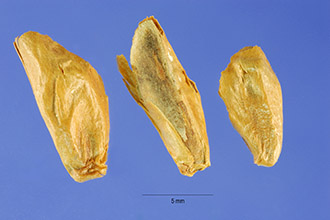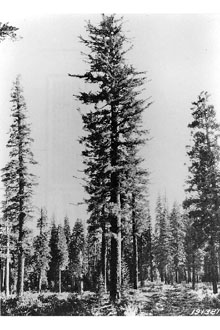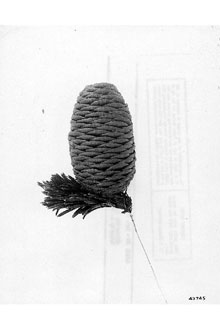Pacific Silver Fir
Scientific Name: Abies amabilis (Douglas ex Loudon) Douglas ex Forbes

| General Information | |
|---|---|
| Usda Symbol | ABAM |
| Group | Gymnosperm |
| Life Cycle | Perennial |
| Growth Habits | Tree |
| Native Locations | ABAM |
Plant Guide
Uses
Pacific silver fir is used in urban landscaping and grown commercially for Christmas trees, Use soil moisture sensors to measure the soil moisture of Pacific Silver Fir., When used for landscaping, sufficient space should be allocated for the relatively large size of mature trees, The soft, light-weight wood is weak and has low durability, It has been used for light construction frames, construction plywood, container veneer, and pulpwood, The dense growth of Pacific silver fir provides cover and protection during the winter for wildlife, Old-growth stands provide habitat for mountain goat, northern spotted owl, Vaux’s swift, western red-backed vole, and the Olympic salamander, Seeds provide food for birds, rodents, and squirrels, while the leaves of growing shoots are browsed by elk,
Status
Please consult the PLANTS Web site and your State Department of Natural Resources for this plant’s current status (e.g. threatened or endangered species, state noxious status, and wetland indicator values).
Description
General: Pine Family (Pinaceae). Pacific silver fir is a U.S. native conifer that ranges from 100 to 230 feet tall and up to 45 inches in diameter at the base. Like all true firs, it has erect, cylindrical cones that are borne near the tips of the uppermost branches. Secondary branches and twigs are typically in pairs, with leaves twisted or curved so that they tend to lie in one plane. Mature cones are 3.5 to 6 inches long and purple. Mature trees are erect, conical in outline, with spreading, spray-like branches and a scaly, gray to whitish bark. Young shoots have a dense, short, pinkish brown pubescence. Most of the needle-like leaves range from 0.5 to 1.3 inches long, are bright green, somewhat flattened, and have notched tips. Distribution: For current distribution, please consult the Plant Profile page for this species on the PLANTS Web site.
Adaptation
Native to the Pacific Northwest, Pacific silver fir ranges from southern Alaska to northern California. Well developed stands are primarily found at elevations from 1,000 to 7,000 feet on the coastal slopes of the Cascades. However, in the northern part of its range, stands occur well below 1,000 feet. Pacific silver fir usually occurs in uniform stands or associated with western hemlock (Tsuga heterophylla). The geographic range is characterized by a maritime to submaritime climate, with an annual precipitation between 40 to 260 inches per year, and average summer temperatures between 57 to 59 degrees F. Plants have a mild frost tolerance and a low tolerance for frozen soil conditions. Soils are usually very moist, somewhat acidic (pH 5), and rich in magnesium and calcium. A thin bark and highly flammable foliage contribute to low levels of resistance to fire.
Establishment
Pacific silver firs reproduce only from seed. Both pollination and seed dispersal are effected by wind. Plants are capable of self-fertilization and produce mature cones and seeds two years after pollination. Cones disintegrate while on the tree and seeds are
Management
Management for most fungal diseases involves thinning at least 25 feet from dead trees and minimizing wounding during logging or trimming. Treating remaining stumps with fungicide or stump removal after logging is useful in preventing further contamination. In some cases, removal of infected trees and trunks should be practiced as soon as disease is diagnosed. Air drying large stumps often reduces chances of further infection.
Pests and Potential Problems
Pacific silver firs are susceptible to several fungal diseased, including Annosus root disease (Heterobasidion annosum). Infected trees may show retarded leader growth, sparse and chlorotic foliage, stem decay, and abortive cones. The most reliable way to detect this disease is by the presence of fruiting bodies in the duff layer at the root collar on the outer bark. Trees become infected by rood contact or by airborne spores falling onto woonds. Other fungal diseases include Indian paint fungus (Echinodontium tinctorium) and laminated root rot (Phellinus weirii). Both can infect stands of trees and result in patches of damaged or dead trees. Trees weakened by disease or poor growing conditions may become infested with fir-engraver beetle (Scolylus ventralis), silver fir beetle (Pseudohylesinus sericeus), or fir root bark beetle (Pseudohylesinus granulatus). In large numbers, these beetles may kill entire trees before any symptoms are observed. Pacific silver firs are also susceptible to Western spruce budworm (Choristeneura occidentalis), Douglas fir tussock moth (Orygia pseudotsugata) infestation. Applying fertilized and varying the age and density of stands reduces the infestation. Balsam wooly aphids (Adelges piceae) are an extremely devastating pest to this species. Infected trees appear swollen with little growth and usually die from the top down within 2 to 3 years. To prevent further infestation, most trees need to be removed and the site rplanted with such species as western hemlock.
Seeds and Plant Production
Plant Production
Plant Production
Cone production may begin at an age of 20 to 30 years. Each cone can produce up to 400 seeds, but the percentage of viable seed ranges from 6.3 to 35 percent. Preferred methods of cone collecting include extension poles with appropriate pruners. Cones should be collected between mid and late August or just prior to disintegration. They should be stored in well-ventilated bags or sacks at temperatures between 70 and 80 degrees until the cones have disintegrated. Seeds can be extracted mechanically by using screens and then cold-stratified under dry conditions at temperatures between 10 and 30 degrees F for 4 to 6 months. Germination is best accomplished by placing them in a moist, well-aerated soil mix at temperatures between 35 and 40 degrees F. Light enhances germination and development of seedlings. Plant can be grown either individually in containers or in flats prior to transplantation. Under field conditions, seed should be sown in the spring at a density of 62.5 to 125 per acre and approximately 0.25 inches deep. During the first few years, growth ranges from 4 to 16 inches annually. Fertilizer combined with thinning enhances growth. Cultivars, Improved, and Selected Materials (and area of origin) Contact your local Natural Resources
Conservation
Service (formerly Soil Conservation Service) office for more information. Look in the phone book under ”United States Government.” The Natural Resources Conservation Service will be listed under the subheading “Department of Agriculture.” Cultivars include a slow-growing, broadly ovoid form, ‘Compacta’ and a low-growing, spreading form with horizontal branches, ‘Spreading Star.’ Retail nurseries in the Pacific Northwest that stock native shrubs and trees may carry the cultivars.
References
Arno, S. & R. Hammerly. 1977. Northwest trees. The Mountaineers, Seattle, Washington. 222 p. Dickman, A. & S. Cook. 1989. Fire and fungus in a mountain hemlock forest. Canadian Journal of Botany 67:2005-2016. Filip, G. & C. Schmitt. 1990. Rx for Abies: Silvicultural options for diseased firs in Oregon and Washington. USDA Forest Service, Pacific Northwest Research Station, Gen. Tech. Report 252. 34 p. Klinka, K., V. Krajina, A. Ceska, & A. Scagel. 1989. Indicator plants of coastal British Columbia. University of British Columbia Press, Vancouver. 288 p. Krajina, V., K. Klinka, & J. Worrall. 1982. Distribution and ecological characteristis of trees and shrubs of British Columbia. University of British Columbia, Vancouver. 131 p. Oliver, C. & R. Kenady (eds.). 1982. Proceedings of the biology and management of true fir in the Pacific Northwest. University of Washington, College of Forest Resources, Contribution No. 45, Seattle. USDA NRCS. 2007. The PLANTS website. http://plants.usda.gov. Accessed 070117. National Plant Data Center, Baton Rouge, Louisiana.
Plant Traits
Growth Requirements
| Temperature, Minimum (°F) | -28 |
|---|---|
| Adapted to Coarse Textured Soils | Yes |
| Adapted to Fine Textured Soils | Yes |
| Adapted to Medium Textured Soils | Yes |
| Anaerobic Tolerance | None |
| CaCO3 Tolerance | Low |
| Cold Stratification Required | Yes |
| Drought Tolerance | Low |
| Fertility Requirement | Low |
| Fire Tolerance | None |
| Frost Free Days, Minimum | 90 |
| Hedge Tolerance | None |
| Moisture Use | Medium |
| pH, Maximum | 6.0 |
| pH, Minimum | 3.3 |
| Planting Density per Acre, Maxim | 700 |
| Planting Density per Acre, Minim | 300 |
| Precipitation, Maximum | 260 |
| Precipitation, Minimum | 38 |
| Root Depth, Minimum (inches) | 36 |
| Salinity Tolerance | None |
| Shade Tolerance | Tolerant |
Morphology/Physiology
| Bloat | None |
|---|---|
| Toxicity | None |
| Resprout Ability | No |
| Shape and Orientation | Erect |
| Active Growth Period | Spring and Summer |
| C:N Ratio | High |
| Coppice Potential | No |
| Fall Conspicuous | Yes |
| Fire Resistant | No |
| Flower Color | Yellow |
| Flower Conspicuous | No |
| Foliage Color | Gray-Green |
| Foliage Porosity Summer | Dense |
| Foliage Porosity Winter | Dense |
| Foliage Texture | Medium |
| Fruit/Seed Conspicuous | No |
| Nitrogen Fixation | None |
| Low Growing Grass | No |
| Lifespan | Long |
| Leaf Retention | Yes |
| Known Allelopath | No |
| Height, Mature (feet) | 165.0 |
| Height at 20 Years, Maximum (fee | 20 |
| Growth Rate | Slow |
| Growth Form | Single Stem |
| Fruit/Seed Color | Brown |
Reproduction
| Vegetative Spread Rate | None |
|---|---|
| Small Grain | No |
| Seedling Vigor | Low |
| Seed Spread Rate | Slow |
| Fruit/Seed Period End | Fall |
| Seed per Pound | 11280 |
| Propagated by Tubers | No |
| Propagated by Sprigs | No |
| Propagated by Sod | No |
| Propagated by Seed | Yes |
| Propagated by Corm | No |
| Propagated by Container | Yes |
| Propagated by Bulb | No |
| Propagated by Bare Root | Yes |
| Fruit/Seed Persistence | No |
| Fruit/Seed Period Begin | Summer |
| Fruit/Seed Abundance | Low |
| Commercial Availability | Routinely Available |
| Bloom Period | Late Spring |
| Propagated by Cuttings | No |
Suitability/Use
| Veneer Product | Yes |
|---|---|
| Pulpwood Product | Yes |
| Post Product | No |
| Palatable Human | No |
| Palatable Browse Animal | Low |
| Nursery Stock Product | No |
| Naval Store Product | No |
| Lumber Product | Yes |
| Fuelwood Product | Low |
| Fodder Product | No |
| Christmas Tree Product | Yes |
| Berry/Nut/Seed Product | No |


